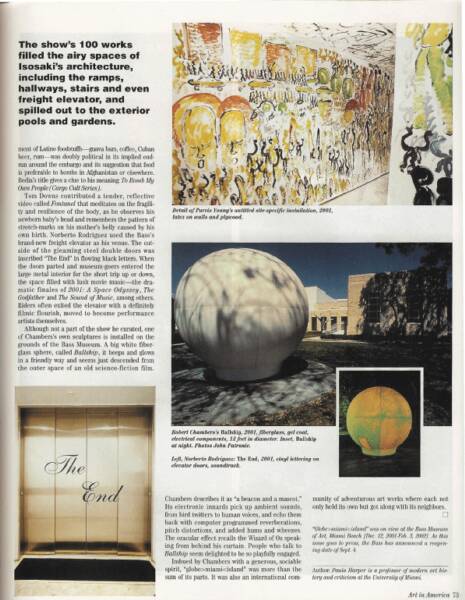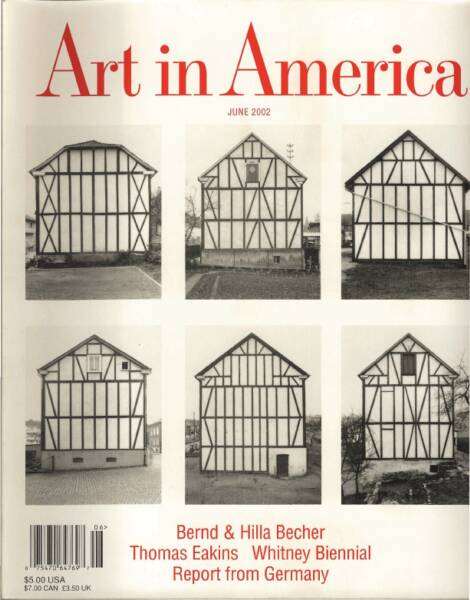

REPORT FROM MIAMI
Bass Forward
A lively group exhibition, featuring some 60 Miami-based artists, recently brought cross-cultural synergy to the newly expanded Bass Museum.
By Paula Harper
A year ago, the Bass Museum of Art in Miami Beach opened its handsome new addition by Arata Isosaki just long enough to display a scheduled traveling show of Russian vanguard art; then it closed to repair water damage sustained during construction and to solve climate-control problems. In early December 2001, the Bass reopened, again temporarily, for an exhibition timed to coincide with Art Basel Miami. Although Art Basel was cancelled due to 9/11 complications, the Bass went forward, nevertheless, with "globe>Miami<island," an ebullient presentation of the work of nearly 60 artists, all with Miami connections, curated by Miami sculptor Robert Chambers. Some of the artists are Miami born and bred, like Chambers himself; some have come to Miami from places all over the globe, and a sizable contingent are from Cuba. The show was big, generous, inclusive and high-spirited. It filled the airy spaces of Isosaki's architecture, including the ramps, hallways, stairs, even the freight elevator, and spilled out to the exterior pools and gardens, At the end of its run on Feb. 2, the Bass closed yet again; it will reopen when its climate control system is functioning properly and its permanent collection (which includes some precious old-master works such as Rubens's Holy Family) can be safely installed. But Diane Camber, director of the Bass, promises that exhibitions of contemporary Miami art will continue and that "this exhibition initiates what I hope will become a biennial at the Bass Museum." "globe>miami<island" included almost 100 works of painting, sculpture, video, photography and installation in abstract, figurative, formalist, conceptual and narrative modes, augmented by performance art on opening night. It arrived at a moment that lent the show historical importance as a state-of-the-art summary, Miami has long been touted as a geographic and cultural crossroads. Now its promise as a vital center for the visual arts appears fulfilled, in what seems like a sudden burst but is actually the result of a synergy developed over the past several years among artists, galleries, alternative spaces, writers, museums and collectors. An early event in this process was the transformation of a soon-to-be-demolished bank tower on Brickell Avenue into a temporary exhibition site by 44 Miami artists, a cross-section of the city's ethnic and racial groups, some of the participants well known and some still students. That experience seems to have generated a more expansive sense of connectedness among the city's several artists' communities, as well as a momentum sustained by Miami's growing art infrastructure. Among the many virtues of "globe>Miami<island" as a landmark exhibition were its relative historical depth and its curatorial breadth. In addition to artists who bring ideas and modes from wide-ranging geographic and cultural sources, it included artists who have been working and showing in Miami for decades, like Robert Thiele, Lynn Golob Geifman, Shahreyar Ataie, Purvis Young, Robert Huff and Salvatore la Rosa. These longtime residents in a city famously dependent on transients helped to create the environment for subsequent generations to thrive, those that included immigrants and exiles like Roberto Behar and Rosario Marquardt from Argentina, Edouard Duval- Carrie from Haiti, Jose Bedia, Pablo Cano and Juan Lezcano from Cuba, as well as established Miamians like Karen Rifas and Chambers himself. The youngest artists are a bumper crop, some homegrown, and some imported. “globe>Miami<island" gave the Miami art community something it had always longed for-a vision of its own history and a sense of its roots.
Chambers says that he intended to create a feeling of "contemporary art overload," a liberating celebration of excess. A walk up Isosaki's switchback ramp to the main exhibition space presented the viewer with a profusion of paintings and large photographs arrayed one above the other, salon style. Over the gap between ramp and wall, Karen Rifas stretched an intricate and airy canopy of threaded leaves that cast faint, fluttering shadows on the surfaces below and asserted the presence of nature amid artifice.
On the ramp's inner wall, Tao Rey's large canvas bearing the words "blah, blah, blah" in almost invisible white-on-white writing accompanied the audible hubbub of viewers. Glexis Novoa's site-specific wall drawing appeared at the top of the ramp. The miniature towers and domes of his metaphysical world rose above a graphite horizon line; their delicate reflections shimmered below. A small group of Naomi Fisher's color photos were hung nearby. In the next room, near Janine Antoni's impressive animal-hide installation Teresita Fernandez spread out, on a large wall, a cool, sensual spectrum of colored acrylic cubes that seemed to float just in front of the surface. In dramatic contrast, Ursula von Rydingsvard's massive, horizontal sculpture was hacked out of apparently ancient wood. Hung heavy with irregularly shaped, blackened weights and titled Ocean Floor, it looked settled deep down but responsive to currents. (She, like Chambers, is a graduate of the University of Miami.) Nearby was a trio of oddly fluid and hallucinatory digital abstractions by Mette Tommerup. With their reflective laminated surfaces, the paintings seemed to change shapes before our eyes like high-tech mandalas in the process of cloning themselves. Bursts of snaredrums and cymbals in a bright Sousa march tempo announced Paul Ramirez Jonas's ramshackle installation of pennants, banners, small TVs, a large red flag on a pole stuck into a janitor's bucket and the computer-programmed, self-playing band instruments. One screen flashed a litany of labor slogans through the ages-"Land to the Peasants," ''Workers of the World Unite," "40 Acres and a Mule," "Bread and Peace"-rallying cries for distant, lost causes. A large monitor displayed the successive times of sunrise in cities around the world, a good reason to celebrate when politics disappoints. Farther along in the high-ceilinged grand hall one encountered an elaborate installation by Cesar Trasobares, Elian in Wonderland, recalling that lively period when Miami passions surged around (and threatened to smother) the little Cuban boy,Elian Gonzalez,who was rescued at sea. It was full of toys, souvenirs, a clutter of documentary photos and inflammatory posters that local critic Alfredo Triff, who is Cubanborn, called "a microcosm of Cuban culture, nationalist kitsch and a caustic analysis worth more than any textbook on the subject." Jose Bedia's colossal wall painting of a dark deity looming over altar-like shipment of Latino foodstuffs-guava bars, coffee, Cuban beer, rum-was doubly political in its implied end-run around the embargo and its suggestion that food is preferable to bombs in Afghanistan or elsewhere.
Bedia's title gives a clue to his meaning: To Bomb My Own People (Cargo Cult Series). Tom Downs contributed a tender, reflective video called Fontanel that meditates on the fragility and resilience of the body, as he observes his newborn baby's head and remembers the pattern of stretch-marks on his mother's belly caused by his own birth. Norberto Rodriguez used the Bass's brand-new freight elevator as his venue. The outside of the gleaming steel double doors was inscribed "The End" in flowing black letters. When the doors parted and museum-goers entered the large metal interior for the short trip up or down, the space filled with lush movie music-the dramatic finales of 2001: A Space Odyssey, The Godfather and The Sound of Music, among others. Riders often exited the elevator with a definitely filmic flourish, moved to become performance artists themselves.
Although not a part of the show he curated, one of Chambers's own sculptures is installed on the grounds of the Bass Museum. A big white fiberglass sphere, called Ballship, it beeps and glows in a friendly way and seems just descended from the outer space of an old science-fiction film.
Chambers describes it as “a beacon and a mascot”. Its electronic innards pick up ambient sounds, from bird twitters to human voices, and echo them back with computer programmed reverberations, pitch distortions, and added hums and wheezes. The oracular effect recalls the Wizard of Oz speaking from behind his curtain. People who talk to Ballship seem delighted to be so playfully engaged. Imbued by Chambers with a generous, sociable spirit, "globe>miami<island" was more than the sum of its parts. It was also an international community of adventurous art works where each not only held its own but got along with its neighbors.